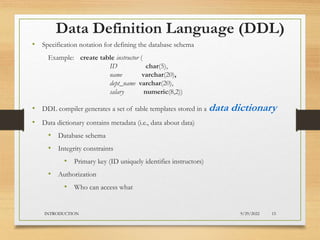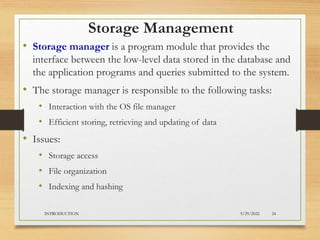DBMS - Introduction.ppt
- 1. INTRODUCTION TO DATABASE MANAGEMENT SYSTEMS 9/29/2022 INTRODUCTION 1
- 2. Outline • The Need for Databases • Data Models • Relational Databases • Database Design • Storage Manager • Query Processing • Transaction Manager 9/29/2022 INTRODUCTION 2
- 3. History of Database Systems • 1950s and early 1960s: • Data processing using magnetic tapes for storage • Tapes provided only sequential access • Punched cards for input • Late 1960s and 1970s: • Hard disks allowed direct access to data • Network and hierarchical data models in widespread use • Ted Codd defines the relational data model • Would win the ACM Turing Award for this work • IBM Research begins System R prototype • UC Berkeley begins Ingres prototype • High-performance (for the era) transaction processing 9/29/2022 INTRODUCTION 3
- 4. History (cont.) • 1980s: • Research relational prototypes evolve into commercial systems • SQL becomes industrial standard • Parallel and distributed database systems • Object-oriented database systems • 1990s: • Large decision support and data-mining applications • Large multi-terabyte data warehouses • Emergence of Web commerce • Early 2000s: • XML and XQuery standards • Automated database administration • Later 2000s: • Giant data storage systems • Google BigTable, Yahoo PNuts, Amazon, .. 9/29/2022 INTRODUCTION 4
- 5. Database Management System (DBMS) • DBMS contains information about a particular enterprise • Collection of interrelated data • Set of programs to access the data • An environment that is both convenient and efficient to use • Database Applications: • Banking: transactions • Airlines: reservations, schedules • Universities: registration, grades • Sales: customers, products, purchases • Online retailers: order tracking, customized recommendations • Manufacturing: production, inventory, orders, supply chain • Human resources: employee records, salaries, tax deductions • Databases can be very large. • Databases touch all aspects of our lives 9/29/2022 INTRODUCTION 5
- 6. University Database Example • Application program examples • Add new students, instructors, and courses • Register students for courses, and generate class rosters • Assign grades to students, compute grade point averages (GPA) and generate transcripts • In the early days, database applications were built directly on top of file systems 9/29/2022 INTRODUCTION 6
- 7. Drawbacks of using file systems to store data • Data redundancy and inconsistency • Multiple file formats, duplication of information in different files • Difficulty in accessing data • Need to write a new program to carry out each new task • Data isolation • Multiple files and formats • Integrity problems • Integrity constraints (e.g., account balance > 0) become “buried” in program code rather than being stated explicitly • Hard to add new constraints or change existing ones 9/29/2022 INTRODUCTION 7
- 8. Drawbacks of using file systems to store data (Cont.) • Atomicity of updates • Failures may leave database in an inconsistent state with partial updates carried out • Example: Transfer of funds from one account to another should either complete or not happen at all • Concurrent access by multiple users • Concurrent access needed for performance • Uncontrolled concurrent accesses can lead to inconsistencies • Example: Two people reading a balance (say 100) and updating it by withdrawing money (say 50 each) at the same time • Security problems • Hard to provide user access to some, but not all, data Database systems offer solutions to all the above problems 9/29/2022 INTRODUCTION 8
- 9. Levels of Abstraction • Physical level: describes how a record (e.g., instructor) is stored. • Logical level: describes data stored in database, and the relationships among the data. type instructor = record ID : string; name : string; dept_name : string; salary : integer; end; • View level: application programs hide details of data types. Views can also hide information (such as an employee’s salary) for security purposes. 9/29/2022 INTRODUCTION 9
- 10. View of Data An architecture for a database system 9/29/2022 INTRODUCTION 10
- 11. Instances and Schemas • Similar to types and variables in programming languages • Instance – the actual content of the database at a particular point in time • Analogous to the value of a variable • Logical Schema – the overall logical structure of the database • Example: The database consists of information about a set of customers and accounts in a bank and the relationship between them Analogous to type information of a variable in a program • Physical schema– the overall physical structure of the database • Physical Data Independence – the ability to modify the physical schema without changing the logical schema • Applications depend on the logical schema • In general, the interfaces between the various levels and components should be well defined so that changes in some parts do not seriously influence others. 9/29/2022 INTRODUCTION 11
- 12. Data Models • A collection of tools for describing • Data • Data relationships • Data semantics • Data constraints • Relational model • Entity-Relationship data model (mainly for database design) • Object-based data models (Object-oriented and Object-relational) • Semistructured data model (XML) • Other older models: • Network model • Hierarchical model 9/29/2022 INTRODUCTION 12
- 13. Relational Model • All the data is stored in various tables. • Example of tabular data in the relational model Columns Rows 9/29/2022 INTRODUCTION 13
- 14. A Sample Relational Database 9/29/2022 INTRODUCTION 14
- 15. Data Definition Language (DDL) • Specification notation for defining the database schema Example: create table instructor ( ID char(5), name varchar(20), dept_name varchar(20), salary numeric(8,2)) • DDL compiler generates a set of table templates stored in a data dictionary • Data dictionary contains metadata (i.e., data about data) • Database schema • Integrity constraints • Primary key (ID uniquely identifies instructors) • Authorization • Who can access what 9/29/2022 INTRODUCTION 15
- 16. Data Manipulation Language (DML) • Language for accessing and manipulating the data organized by the appropriate data model • DML also known as query language • Two classes of languages • Pure – used for proving properties about computational power and for optimization • Relational Algebra • Tuple relational calculus • Domain relational calculus • Commercial – used in commercial systems • SQL is the most widely used commercial language 9/29/2022 INTRODUCTION 16
- 17. SQL • The most widely used commercial language • SQL is NOT a Turing machine equivalent language • SQL is NOT a Turing machine equivalent language • To be able to compute complex functions SQL is usually embedded in some higher-level language • Application programs generally access databases through one of • Language extensions to allow embedded SQL • Application program interface (e.g., ODBC/JDBC) which allow SQL queries to be sent to a database 9/29/2022 INTRODUCTION 17
- 18. Database Design • Logical Design – Deciding on the database schema. Database design requires that we find a “good” collection of relation schemas. • Business decision – What attributes should we record in the database? • Computer Science decision – What relation schemas should we have and how should the attributes be distributed among the various relation schemas? • Physical Design – Deciding on the physical layout of the database The process of designing the general structure of the database: 9/29/2022 INTRODUCTION 18
- 19. Database Design (Cont.) • Is there any problem with this relation? 9/29/2022 INTRODUCTION 19
- 20. Design Approaches • Need to come up with a methodology to ensure that each of the relations in the database is “good” • Two ways of doing so: • Entity Relationship Model • Models an enterprise as a collection of entities and relationships • Represented diagrammatically by an entity-relationship diagram: • Normalization Theory • Formalize what designs are bad, and test for them 9/29/2022 INTRODUCTION 20
- 21. Object-Relational Data Models • Relational model: flat, “atomic” values • Object Relational Data Models • Extend the relational data model by including object orientation and constructs to deal with added data types. • Allow attributes of tuples to have complex types, including non- atomic values such as nested relations. • Preserve relational foundations, in particular the declarative access to data, while extending modeling power. • Provide upward compatibility with existing relational languages. 9/29/2022 INTRODUCTION 21
- 22. XML: Extensible Markup Language • Defined by the WWW Consortium (W3C) • Originally intended as a document markup language not a database language • The ability to specify new tags, and to create nested tag structures made XML a great way to exchange data, not just documents • XML has become the basis for all new generation data interchange formats. • A wide variety of tools is available for parsing, browsing and querying XML documents/data 9/29/2022 INTRODUCTION 22
- 23. Database Engine • Storage manager • Query processing • Transaction manager 9/29/2022 INTRODUCTION 23
- 24. Storage Management • Storage manager is a program module that provides the interface between the low-level data stored in the database and the application programs and queries submitted to the system. • The storage manager is responsible to the following tasks: • Interaction with the OS file manager • Efficient storing, retrieving and updating of data • Issues: • Storage access • File organization • Indexing and hashing 9/29/2022 INTRODUCTION 24
- 25. Query Processing 1. Parsing and translation 2. Optimization 3. Evaluation 9/29/2022 INTRODUCTION 25
- 26. Query Processing (Cont.) • Alternative ways of evaluating a given query • Equivalent expressions • Different algorithms for each operation • Cost difference between a good and a bad way of evaluating a query can be enormous • Need to estimate the cost of operations • Depends critically on statistical information about relations which the database must maintain • Need to estimate statistics for intermediate results to compute cost of complex expressions 9/29/2022 INTRODUCTION 26
- 27. Transaction Management • What if the system fails? • What if more than one user is concurrently updating the same data? • A transaction is a collection of operations that performs a single logical function in a database application • Transaction-management component ensures that the database remains in a consistent (correct) state despite system failures (e.g., power failures and operating system crashes) and transaction failures. • Concurrency-control manager controls the interaction among the concurrent transactions, to ensure the consistency of the database. 9/29/2022 INTRODUCTION 27
- 28. Database Users and Administrators Database 9/29/2022 INTRODUCTION 28
- 30. Database Architecture The architecture of a database systems is greatly influenced by the underlying computer system on which the database is running: • Centralized • Client-server • Parallel (multi-processor) • Distributed 9/29/2022 INTRODUCTION 30





























































![DOC-20241022-WA0000[1] - Read-Only.pptx](https://cdn.slidesharecdn.com/ss_thumbnails/doc-20241022-wa00001-read-only-241204064442-a137f7c3-thumbnail.jpg?width=560&fit=bounds)



































